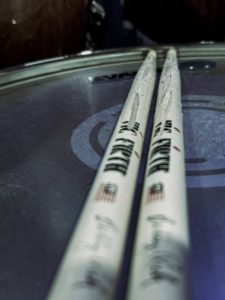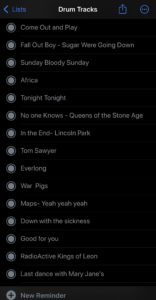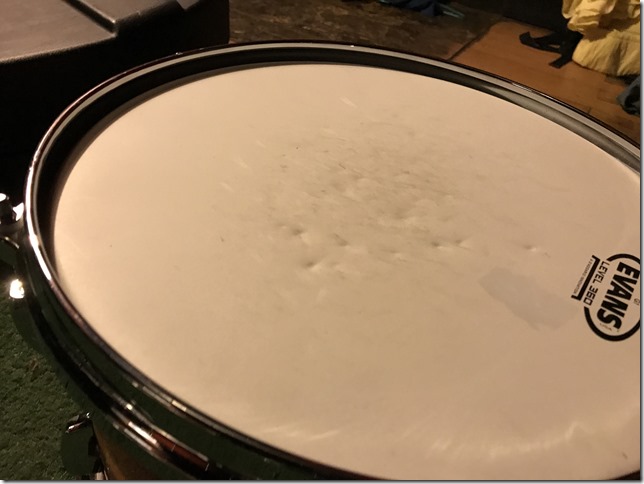Look ma, I’m a TikTok star, or at least trying to be. Not really.
“Guess this song by its Drum Track.”
During the pandemic, when I couldn’t practice with my band, I played around with playing drum parts to some famous songs and posting them on Instagram and Facebook. It was a fun game and a good excuse to spend some time behind the drum kit, but I shelved the idea after a month.
This winter I decided to pick it back up to experiment with short-form video sharing on Instagram Reels, YouTube Shorts, and TikTok. Now, over fifty videos later, I’ve learned a lot about reproducing drum tracks and these video-sharing platforms.

Choosing and Recording the Track
Not just any song can work for “Guess this”. The song needs to be relatively popular and have a distinctive beat or groove that can be recognized by non-drummers. That’s proven to be easier said than done, especially with songs within the last decade. As rock has been dying out, current pop songs are produced beats that simply repeat the same two measures. Using the iOS reminders app, I’ve put together a running list using my iOS reminders app of primarily rock songs over the last 50 years, and add to it as I encounter them.
I’ve recorded my share of drum tracks, where I pay homage and offer my interpretation of the song. Approaching these songs, however, requires me to be faithful as possible to the original recordings, trying to emulate them to the best ability. Also, unlike a drum cover, I don’t need to nail the whole song, just aim for a solid 40-60 second segment for the video.
I do have to admit to cheating a bit: I load the original song into the Digital Audio Workstation (DAW) and record my take alongside the regular drum track. It helps keep me in check and enables me to compare the two parts. While I’m doing that, I load the track into the Moises App which enables me to break down the different instruments and create a drumless track. I then export the track back into the DAW, align it with the original then export the rendered track with my drums, followed by exporting a “drums only” track with the drums muted. All the while, I have my phone on the tripod, taking a video of the performance.
Once I have my footage, I import them into Adobe Premiere, line up the audio, and look for that distinctive 45-60 second clip I can use. I then find a point about 30-40 seconds into the song where I can transition from the “drums only” clip to reveal the song. After applying an audio fade between the tracks, I export the video and get it back onto my phone using OneDrive.
Posting the video
At this point, I have a rendered video with the final audio, but I now need to insert the clues. I’ve made it a point to use each video platform’s editing tools to apply the text, as I’ve read that videos are exported at a lower quality having the watermark can make the video perform worse.
Starting with Instagram, I import the video and get to work on the text.
- The title: “Guess this song by its drum track.”
- The year it was released
- The genre – I usually get this from the Wikipedia entry
- A hint, usually retrieved from SongFacts
After setting up the text, I set the duration, starting with the hint so that it appears for 8-10 seconds before the full song kicks in. I then work my way backward, setting the genre and release year around 5 seconds each. I leave the title up but have it disappear once the song is revealed. Before I move to the next screen, I copy the hint into Clipboard++ so that I can use it in the other apps. I go to the posting screen and set my title to “Guess this song by its drum track: “, increment the number, add some tags, then publish the video out into the world.
I then go to TikTok and Youtube and repeat the above steps.
Lessons I’ve Learned
These video platform algorithms are complete crapshoots, but I’ve noticed some trends in each platform:
- Instagram has shown the most variance in my performance. My floor has around 250 views, my average is between 800-1000 views, and I’ve had a handful of videos go over 10k views (my highest being 14.4k). I also share the Reel on Facebook and those views tend to be in the 100-500 range.
- TikTok has the lowest number of views, but the highest number of likes and comments. As far as views, I have videos that haven’t reached 100 views, but most tend to top out between 250-300. My highest-viewed video was at 2,200.
- YouTube Shorts is the quickest to accumulate views but always tops out below 1,500. I’ve had a few videos that are duds out of the gate, at less than 40 views. The comments on YouTube are the meanest by far.
As far as video posting mobile apps, YouTube has the best editor for what I’m doing (which is quickly setting durations of text layers). Instagram’s Reels interface had the steepest learning curve, especially when it comes to setting durations.
My videos seem warmly received, for the most part. As I mentioned, YouTube commenters are especially critical, which increases with the popularity of the song. I’ve learned to simply remove the mean comments and not even warrant a response, but I swear that as soon as I remove a comment, YouTube slows down the view exposure.
I was worried that I would run out of songs, but after doing this for over 4 months, the number of songs on my “ToDo” list outnumbers the ones I’ve done. At this point, I’ve found this to be a really fun way to improve my drumming and play in this video space. It’s been a great outlet and I’m looking forward to the next 50!
Whether you use TikTok, Instagram, or YouTube shorts, I’d love for you to check out my videos and see how many you can get! I’m also taking song suggestions as well!

